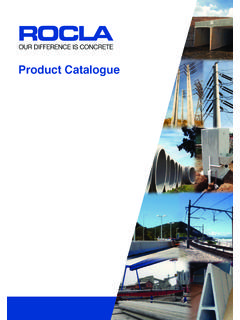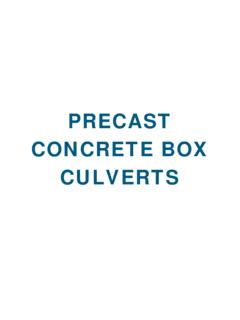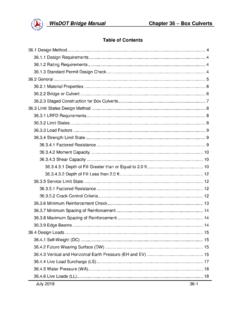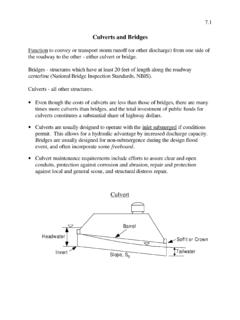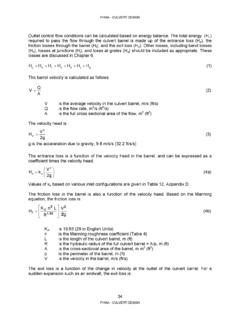Transcription of Pipe and Infrastructural Products Division - Rocla
1 Pipe and Infrastructural Products Division CONCRETE PIPE and PORTAL culvert INSTALLATION MANUAL Page 1 Pipe & Portal culvert Installation Manual 2003 CONCRETECONCRETECONCRETECONCRETE PIPE ANDPIPE ANDPIPE ANDPIPE AND PORTAL CULVERTPORTAL CULVERTPORTAL CULVERTPORTAL culvert INSTAINSTAINSTAINSTALLATION LLATION LLATION LLATION MANUALMANUALMANUALMANUAL (Reprinted 2003) Published by: Pipe and Infrastructural Products Division of Concrete Manufacturers Association Portland Park P O Box 168 Halfway House 1685 Tel: (011) 805-6742 Fax: (011) 315-4683 Member Companies PRODUCER MEMBERS Concrete Units (Pty) Ltd Craig Concrete Products (Pty) Ltd Fort Concrete (Zimbabwe) (Pty) Ltd Infraset (Pty) Ltd Kwena Rocla (Pty) Ltd Rocla (Pty) Ltd Salberg Concrete Products (Pty) Ltd Southern Pipeline Contractors (Pty) Ltd PRODUCER MEMBERS Alpha (Pty) Ltd C&CI Engineered Linings (Pty) Ltd International Transport Corporation Lafarge Aluminates Southern Africa (Pty) Ltd Lafarge South Africa (Pty) Ltd Natal Portland Cement Company (Pty)
2 Ltd Pretoria Portland Cement Company Ltd Although every effort has been made to ensure the accuracy of the information given, it is not possible for the CMA to accept responsibility for work prepared on the basis of this Manual ISBN 0-620-13661-8 Page 2 Pipe & Portal culvert Installation Manual 2003 Concrete is possibly the most widely accepted material for stormwater pipes, culverts, sewer lines and many other applications. This acceptance stems from concrete s ability to be moulded into almost any shape and to satisfy a broad range of performance requirements in terms of strength and durability. To meet these needs, the concrete pipe industry in South Africa has grown tremendously in the past sixty years. The use of precast culverts has, in recent years, become popular as they offer many advantages over cast-in-place culverts.
3 Modern technology and the acceptance of SABS standards ensure that Products of uniformly high quality are produced. Provided sound design and installation methods are followed, the concrete pipe and portal culvert will give satisfactory hydraulic and structural performance for many years. This Manual is intended to cover all aspects of concrete pipe and portal culvert handling, installation and site testing. Being a Manual, it does not attempt to take the place of established texts, but rather to give sufficient information to enable site decisions to be taken quickly and to guide contractors along the correct paths. This Manual has been prepared for the guidance of specifying bodies and contracting organisations using concrete pipes and portal culverts, by the Concrete Pipe Association of Southern Africa in consultation with its member companies.
4 Publications by the American Concrete Pipe Association have been freely referred to and acknowledgement is made to this Organisation. 1. Introduction p3 General Scope Selection of Product Strength Study of Product Specifications Installation Conditions Pre-construction Activities 2. Ordering, Receipt and Acceptance of Product p4 Information Required Receipt and Acceptance of Product Action when Products do not Comply 3. Handling and Offloading p5 Concrete Products Site Access Distribution Storage Area Acceptance of Product Offloading of Pipes Offloading of Culverts Stacking of Pipes Stacking of Culverts Repairing Minor Damage Storage of Ancillary Items 4. Surveying p9 Preliminary Work Centre Lines Levels 5.
5 Excavation p10 General Safety Trench Widths and Depth De-watering Preparing Trench Bottom 6. Bedding p14 Purpose of Bedding Bedding Material Types of Bedding Placement of Bedding 7. Pipe Laying p16 Lowering of Pipe Line and Grade Jointing Curves 8. culvert Bases p18 General Precast Base Slabs Cast-in-Place Bases Placing of Culverts Joint Sealing 9. Backfilling p20 General Final Backfilling Special Technique for Backfilling Culverts 10. Special Conditions p22 Steep Gradient Unstable Ground Passing through Rigid Structures Anchor Blocks Elliptically Reinforced Pipes Flotation 11. Field Testing p22 Water Test Air Testing 12. Special Applications p23 Jacking of Pipes and Culverts PREFACE CONTENTS 2003 Pipe & Portal culvert Installation Manual Page 3 13.
6 INTRODUCTION GENERAL The interdependent relationship between design and installation requires installation practices that ensure satisfactory hydraulic and structural performance of the complete pipe or culvert line. The engineering design of any project, described in the specifications and drawings, must be properly executed during construction. The Clerk of Works, as a representative of the Engineer, shares responsibility with the Contractor for ensuring that the pipe or portal culvert is installed in accordance with the contract documents. Proper inspection requires careful attention to site operation, but should not duplicate the detailed inspection and testing carried out by the pipe manufacturer. Supervisory personnel directly associated with the installation should have a basic understanding of design principles so that the extent and limitations of the project specification and drawings can be interpreted correctly.
7 This Manual cannot, and should not, be used as a textbook, nor can it relieve the Designer and the Contractor of the need for making a thorough study of the theoretical and practical problems that occur in practice. When in doubt, advice should be sought from a reputable manufacturer. SCOPE This Manual describes proven methods for installation of precast concrete pipes and portal culverts. The selection, manufacture and installation of precast concrete pipes and culverts are covered by the following: SABS 0102 The Selection of Pipes for Buried Pipelines Parts, I, II. SABS 676 Reinforced Concrete Pressure Pipes. SABS 677 Concrete Non-Pressure Pipes SABS 986 Precast Reinforced Concrete Culverts. SABS 974 Rubber Joint Rings (Non-Cellular).
8 SABS 1200 DB Civil Engineering Construction: Earthworks (Pipe Trenches). SABS 1200 L Civil Engineering Construction: Low Pressure Pipelines. SABS 1200 LB Civil Engineering Construction: Bedding (Pipes). SABS 1200 LD Civil Engineering Construction: Sewers. SABS 1200 LE Civil Engineering Construction: Stormwater Drainage. SABS 0120 Code of Practice for Use with Standardised Specifications for Civil Engineering Construction and Contract Documents. SELECTION OF PRODUCT STRENGTH Once the size of product has been determined, the selection of product strength has six logical steps: calculate deadloads; calculate internal pressure; calculate live loads; choose bedding factor; choose safety factor; select required product class. It is important to note that there are always a number of options, which need to be considered in order to find the optimum solution.
9 Generally it is more economic to use a high strength pipe with a low class bedding. Reference to the Concrete Pipe Handbook, published by the Concrete Pipe Association of Southern Africa, will be of assistance with most of the problems that can occur with pipe selection. Alternatively, Designers and Contractors should consult a concrete pipe manufacturer. STUDY OF PROJECT SPECIFICATION The drawings that are either supplied by the Engineer or from part of the contract documents should be studied thoroughly for all salient features. Make a note of the locations, numbers and types of all appurtenant structures and fittings such as manholes, junctions, tees, valves (sluice, air and scour) and bends. Using the information available on the drawings, determine: height of fill above the product; any superimposed or live loads; type of installation ( trench, embankment, etc.)
10 ; whether there are any special conditions. Determine from the documents the class of bedding and type of bedding materials specified. The information gleaned in the paragraphs above should be used to check the specified strength class of the pipes or culverts. This kind of check may seem superfluous, but could prevent the Page 4 Pipe & Portal culvert Installation Manual 2003 product from sustaining loads in excess of those permitted for the strength class used. If overload conditions occur these may lead to the pipes or culverts cracking or even collapsing. Equipment and details of field testing, if required, should be established at the start of the project. It will have a direct bearing on the pipe or culvert laying programme and sufficient time should always be allowed to acquire the specialised equipment.
